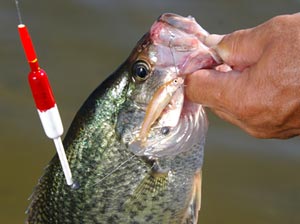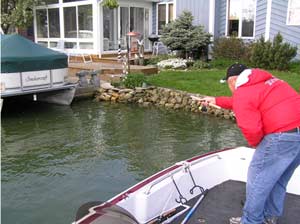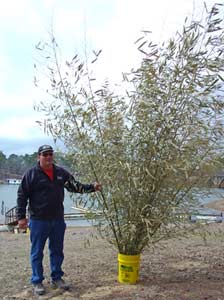
What's the toughest time of year to catch crappie? Survey your buddies who fish year-round and chances are good you'll find them in total agreement: finding and catching America's favorite panfish is most difficult during the summer-to-fall transition period.
 |
| Arkansas crappie guide Jerry Blake uses slip float rigs, cricket hooks and live minnows to entice transition crappie on bamboo and brush fish attractors placed at a variety of depths. |
As summer's heat gives way to autumn's comfort, days grow shorter and nights grow longer. The water temperature drops, and as favorable oxygen levels return throughout the water column, crappie start roaming like nomads. One day they're deep, the next they're shallow, and the day after that they're suspended at mid-depths. Pinpointing schools can be as frustrating as trying to fillet a fish with a butter knife.
So what's an angler to do? One good idea is consulting with folks who are on the water more than most this season — folks like fishing guides and pro anglers. Years of experience give these fishermen a special knack for dealing with tough situations. When fishing gets difficult, they employ specialized tactics that can turn a potentially dismal day into a memorable crappie-catching experience. Here are some of those tactics that can help you catch more crappie this season.
Shooting Pontoons
Early-fall fishing can be extra-tough on northern canal lakes frequented by fishermen such as Russ Bailey, a pro angler/crappie guide from St. Mary's, Ohio, who hosts the Midwest Crappie TV series. These waters, built in the 1800s to support canal systems, are shallow and bowl-shaped, with little natural cover and no drop-offs, ledges or channels to which transition crappie normally relate. Although they're often brimming with slabs, fishing them presents special challenges.
"Shooting pontoons is my favorite technique on these lakes during the transition period," says Bailey. "Pontoon boats provide shade attractive to crappie that have started moving back into the shallows. To catch these fish, I use B'n'M Poles' 5-1/2-foot Sharpshooter rod and a spinning reel spooled with 6-pound-test, Hi-Vis Yellow Sufix line. My lure is a 1/32-ounce Blakemore Road Runner head with a Hot Grub body by Southern Pro Lures."
Shooting requires practice to perfect but is easy to learn, Bailey says. The angler pinches the lure carefully, pulls the rod back like a bow, aims and releases, letting the lure fly beneath the structure.
 |
| Master crappie angler Russ Bailey demonstrates how to "shoot" a lure under a pontoon boat |
"Most pontoons are situated with their front against the sea walls," says Bailey. "This leaves the back of the pontoon area for you to shoot under. Shoot as far under the pontoon as possible. If you only get a couple of feet back, you may catch a few crappie but not as many as you could.
"After you shoot the jig, allow it to fall and watch your line closely," he continues.
"You'll usually see line movement before you feel a strike because most fish strike as the lure drops. If the line jumps or moves, set the hook immediately. If you don't get a strike during the fall, use a slow, steady retrieve. The Road Runner blade and Hot Grub tail are hard for crappie to resist. It's common to catch 10 to 20 fish under one pontoon."
Creating Cover and Fishing it Right
Jerry Blake of Action Fishing Trips Guide Service guides anglers on Arkansas' Lake Greeson, a 7,000-acre Corps of Engineers impoundment west of Hot Springs. He's on the water throughout the summer-fall transition, helping clients catch limits of big Arkansas slabs. One secret to his success, he says, is placing man-made fish attractors in locations where they'll attract crappie as the fish move about this season. "It's important to have your attractors at a variety of depths in areas where transition crappie are most likely to congregate," he says. "Good locales include points extending into deep channels, inside creek-channel bends and drop-offs from flats to creek channels. When cover is placed in such places, crappie can easily seek out the depth they are most comfortable in without having to leave the area, and the angler can follow them as they move from one depth to another. Depending on the depth of the lake, it's helpful to have cover in water as shallow as 10 feet and as deep as 45 feet."
Blake's clients typically fish with live minnows, and his rigs are tailored to catching this season's often-persnickety crappie.
"I prefer No. 6, light-wire, Aberdeen cricket hooks because they allow fishing in the brush-where transition crappie are more likely to be-with fewer hang-ups," he says. "Cricket hooks also will straighten on the 8-pound line we use without disturbing the brushpiles if we get hung up, and they allow us to use smaller minnows, which are more effective than large minnows on this season's sluggish crappie.
 |
| Jerry Blake stands beside one of the bamboo fish attractors (crappie condos, he calls them) he'll place in strategic places within Arkansas' Lake Greeson. |
"I also use 1/2-inch, pencil-style slip floats and bobber stops, which allow us to present baits at exact depths and offer little resistance when Ol' Finicky starts snacking on our minnows," Blake continues. "In addition, I use 10-foot jig poles with spinning eyes, like B'n'M's Richard Williams Crappie Wizard Series, which keep our presentation away from the boat so we're not directly above the cover we're fishing. All these things together-the right cover in the right places fished with the right bait, tackle and presentation-help us enjoy successful fishing throughout the summer/fall transition."
Fast Trolling
Poplar Bluff, Missouri-native Tim Huffman has penned several excellent books and hundreds of articles on crappie fishing. He may be the best-known crappie journalist in America. And because he fishes for crappie many days year-round, he's one of the most knowledgeable, too.
"Transition crappie are on the move, and finding them must be the angler's first priority" he says. "Because of this, I like to use an aggressive technique. Fast trolling, also called long lining, lets me cover lots of water and present baits at different depths and a variety of speeds."
Huffman's favorite structure to fish this way is the top of a mid-depth or shallow drop-off.
"Fast trollers have racks with pole holders so they can use multiple poles, usually six or eight," he notes. "However, you can do the same thing by holding a pole out each side of the boat. Use a 1/32- or 1/16-ounce, curlytail jig, let out 40 feet of line and then use your trolling motor to control the boat. Boat speed determines lure depth, so pay close attention to what you are doing and try to keep the baits at the most likely depths.
"When you find fish," he continues, "you can turn around and make more trolling runs through the area. Or, try switching to a method that lets you concentrate on a single hotspot. Casting is a good choice because it allows you to quickly work specific cover. You aren't wasting time fishing unproductive water. When the action slows, go back to fast trolling to find more crappie."
Sailing for Crappie
Tennessee fishing guide Jim Duckworth says he often "sails" for transition crappie.
"This time of year, crappie schools often hunt shad on big flats," he says. "On breezy days, I catch them by placing sixteen 8- to 16-foot B'n'M rods in Driftmaster T-Bar holders and letting the wind blow me across these flats. My reels are spooled with 8-pound Berkley Trilene 100-percent Fluorocarbon, and my lures-1/8- to 1/16-ounce Blakemore Road Runners-are set from 8 to 15 feet deep until I determine the depth where crappie are feeding. As I drift, I use a Humminbird 787 sonar/GPS combo to mark my path. This allows me to retrace a path when I start catching crappie, using my trolling motor to keep me on course. If it's extremely windy, I put out one or two MinnKota driftsocks to slow the boat to 1.6 mph or slower. This is one of the best ways I know to find and catch crappie this time of year."
- 14354 views

